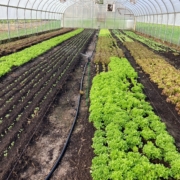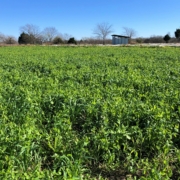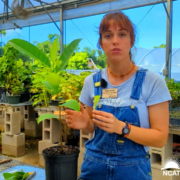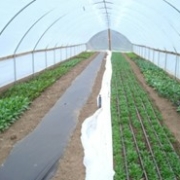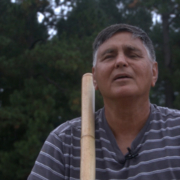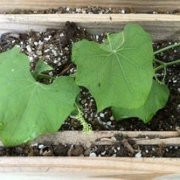Crop Selection and Planting Schedules for Winter High Tunnel Production
 Print This Post
Print This Post
By Chris Lent, NCAT Agriculture Specialist
Spring is a hard time for growers to think about winter growing, but since some winter-harvested crops are planted mid to late summer, spring isn’t a bad time to start thinking about crop selection and a planting schedule for the winter high tunnel. High tunnels are one of the best tools available for growers to extend the season and increase revenue. In this high tunnel season extension blog series, I’m covering topics like purchasing and siting, soil fertility, and pest management. In today’s post, I’ll focus on crop selection and planting schedules.
Almost all crops benefit in quality and production when grown under the protection of a high tunnel, so how do you decide on the best crops to grow inside your tunnel to extend the season? If you’re growing for yourself and your family, you are only limited in choice by what crops can grow in your region and by your own preferences. If you’re growing to sell, then marketability, yield, quality, pest resistance, and length of time to harvest all become important factors in crop and variety selection. That’s true for both field grown and high tunnel production, but high tunnel crops need to do well in the unique temperature and humidity conditions created in a high tunnel. So, when selecting crop types and varieties for fall and winter production in a tunnel, fungal disease resistance, bolt resistance, and cold hardiness become the most important additional considerations.
To see what cold-hardy crops there are to choose from, you can investigate vegetable crop trials done by agricultural research stations in your region. Or you can look at what crops other winter growers rely on as a starting point. Some seed companies have done extensive crops trials to find varieties for winter growing in tunnels, and their catalogs and websites can give good guidance on what crops are well suited for high tunnel season extension. Some offer planting schedule templates, as well. Johnny’s Selected Seeds, for instance, offers an overwintering planting chart that allows growers to adjust planting dates based on the latitude of their farm and the corresponding time of year when daylight becomes 10 hours or less each day. This part of the year was coined the Persephone Period by Eliot Coleman, a pioneer in winter growing, and marks the portion of the year when low light and temperatures slow crop growth significantly. You can find day length information for your area with resources like the Sunrise and Sunset Calculator.
| Cold-hardy Crops | |
| Light Frost (28-32°F | Frost-hardy (24-28°F) |
| Beets | Brussels sprouts |
| Broccoli | Chinese cabbage |
| Cauliflower | Collards |
| Carrots | Endive |
| Cabbage | Kale |
| Celeriac | Kohlrabi |
| Celery | Lettuce |
| Onion, garlic, chives (plants | Mustard greens |
| Parlsey | Onion (sets and seeds) |
| Parsnip | Pea |
| Radish | Potato |
| Swissh chard | Rhubarb |
| Rutagaba | |
| Salsify | |
| Spinach | |
| Turnip | |
| Source: MSU Extension, Identifying and preventing freeze damage in fall vegetables |
|
Planting times will vary greatly depending on the area of the country, but you can put winter-grown crops into two basic categories: winter harvest crops, and overwintered crops for spring harvest. For example, crops like cabbage, cauliflower, broccoli, Brussels sprouts, beets, leeks, carrots, collards, and turnips should be started in June and July in the north to be harvested well into December. Shorter-season crops like lettuce, endive, arugula, scallions, endive, radishes, Asian greens, claytonia, mâché, kale, and spinach should be started in succession plantings in August through October for both fall harvests and to overwinter and harvest in late winter and into spring.
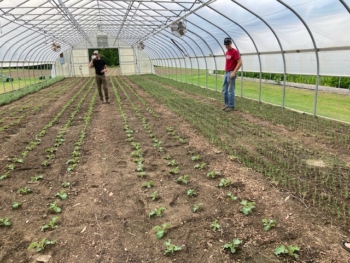
Kale and onions in a New Hampshire tunnel planted in August for winter harvest. Photo: Chris Lent, NCAT
Crops that are planned for holiday markets through December need to be mature by the onset of the Persephone Period in your area. Row covers are used to protect crops inside the tunnel to maintain high quality until they are harvested. A few crops like chard, spinach, and some Asian greens will continue some new growth during the Persephone Period, but most will not. Some winter growers will take a much-needed break during the slow growth period of late December and January before starting to harvest from their tunnels again in February. Early February is also the time of year that it makes the most sense to start seeding new crops in the tunnel again to succeed overwintered crops as they run low or start to bolt.
Where I live in Pennsylvania, the Persephone Period is from November 12 to January 30. I would plan my last planting of overwintered crops, so they are past the seedling stage and into the vegetative stage of growth by mid-November. I rely on days to maturity (DTM) information listed in seed catalogs and on seed packets as a guide to schedule plantings so that crops will be mature enough to overwinter or harvest as needed. Remember that DTM is usually figured from the date of transplant on commonly transplanted crops, and from the time of sowing in commonly direct seeded crops. Seed catalogs should indicate how they define DTM for each of their seed varieties. The temperature fluctuations in late winter inside a tunnel can cause overwintered crops to bolt. Scheduling plantings so the overwintered crops aren’t too mature before they go dormant in the fall and choosing bolt-resistant varieties can delay bolting in the spring. Once you have been growing for a few years, your own records on crop choice, varieties, and planting dates will be your best source of information moving forward.

Spinach and Asian greens in a tunnel in December in Southern Pennsylvania. Photo: Chris Lent, NCAT
Even cold-hardy plants benefit from being systematically acclimated to colder temperatures as fall progresses. Doing this can improve the crops’ ability to survive when freezing temperatures become a regular occurrence. This can be looked at similarly to the hardening-off process for seedlings before transplanting in the spring. By monitoring temperatures closely and ventilating the high tunnel to bring temperatures down close to freezing, crops will quickly adapt to colder and even freezing temperatures. This takes time and attention, and many growers simply rely on the natural gradual decrease in temperatures that occurs in the fall to harden off their tunnel corps. If taking this approach, you should still manage the tunnel to guard against quick and large temperature fluctuations that could damage the crop. An automated ventilation system using an electronic controller with temperature setpoints can help with acclimating crops by giving farmers more precise control over the temperatures inside the tunnel.
There is a lot that goes into selecting and scheduling for winter high tunnel production. Springtime is not too early to start the process of selecting crops and varieties, putting together a planting schedule, and ordering seeds. Choosing cold-hardy crops and varieties that are bolt- and disease-resistant, along with creating a well-timed planting schedule can keep harvests coming through the winter and into the spring.
Related ATTRA Resources:
Purchasing and Siting a High Tunnel to Extend the Growing Season
Specialty Crops for Cold Climates
Scheduling Vegetable Plantings for Continuous Harvest
Sustainable Season Extension: Considerations for Design
Other Resources:
Managing the Environment in High Tunnels for Cool Season Vegetable Production
High Tunnel Planting Scheduling – Working Out a Schedule for Successive Plantings
Season Extenders and Growing Fall Vegetables
This blog is produced by the National Center for Appropriate Technology through the ATTRA Sustainable Agriculture program, under a cooperative agreement with USDA Rural Development. ATTRA.NCAT.ORG.

